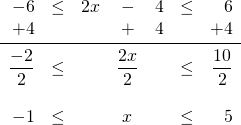Chapter 4: Inequalities
4.3 Linear Absolute Value Inequalities
Absolute values are positive magnitudes, which means that they represent the positive value of any number.
For instance, | −5 | and | +5 | are the same, with both having the same value of 5, and | −99 | and | +99 | both share the same value of 99.
When used in inequalities, absolute values become a boundary limit to a number.
Example 4.3.1
Consider ![]()
This means that the unknown ![]() value is less than 4, so
value is less than 4, so ![]() becomes
becomes ![]() However, there is more to this with regards to negative values for
However, there is more to this with regards to negative values for ![]()
| −1 | is a value that is a solution, since 1 < 4.
However, | −5 | < 4 is not a solution, since 5 > 4.
The boundary of ![]() works out to be between −4 and +4.
works out to be between −4 and +4.
This means that ![]() ends up being bounded as
ends up being bounded as ![]()
If the inequality is written as ![]() , then little changes, except that
, then little changes, except that ![]() can then equal −4 and +4, rather than having to be larger or smaller.
can then equal −4 and +4, rather than having to be larger or smaller.
This means that ![]() ends up being bounded as
ends up being bounded as ![]()
Example 4.3.2
Consider ![]()
This means that the unknown ![]() value is greater than 4, so
value is greater than 4, so ![]() becomes
becomes ![]() However, the negative values for
However, the negative values for ![]() must still be considered.
must still be considered.
The boundary of ![]() works out to be smaller than −4 and larger than +4.
works out to be smaller than −4 and larger than +4.
This means that ![]() ends up being bounded as
ends up being bounded as ![]()
If the inequality is written as ![]() then little changes, except that
then little changes, except that ![]() can then equal −4 and +4, rather than having to be larger or smaller.
can then equal −4 and +4, rather than having to be larger or smaller.
This means that ![]() ends up being bounded as
ends up being bounded as ![]()
When drawing the boundaries for inequalities on a number line graph, use the following conventions:
For ≤ or ≥, use [brackets] as boundary limits.![]()
For < or >, use (parentheses) as boundary limits. ![]()
| Equation | Number Line |
|---|---|
 |
|
 |
|
 |
|
 |
When an inequality has an absolute value, isolate the absolute value first in order to graph a solution and/or write it in interval notation. The following examples will illustrate isolating and solving an inequality with an absolute value.
Example 4.3.3
Solve, graph, and give interval notation for the inequality ![]()
First, isolate the inequality:
![Rendered by QuickLaTeX.com \[\begin{array}{rrrrrl} -4&-&3|x|& \ge & -16 &\\ +4&&&&+4& \text{add 4 to both sides}\\ \midrule &&\dfrac{-3|x|}{-3}& \ge & \dfrac{-12}{-3}&\text{divide by }-3 \text{ and flip the sense} \\ \\ &&|x|&\le & 4 && \end{array}\]](https://pressbooks.bccampus.ca/intermediatealgebrakpu/wp-content/ql-cache/quicklatex.com-ce4c1d0e4a8313f690bffc15315f0dce_l3.png)
At this point, it is known that the inequality is bounded by 4. Specifically, it is between −4 and 4.
This means that ![]()
This solution on a number line looks like:

To write the solution in interval notation, use the symbols and numbers on the number line: ![]()
Other examples of absolute value inequalities result in an algebraic expression that is bounded by an inequality.
Example 4.3.4
Solve, graph, and give interval notation for the inequality ![]()
This means that the inequality to solve is ![]() :
:


To write the solution in interval notation, use the symbols and numbers on the number line: ![]()
Example 4.3.5
Solve, graph, and give interval notation for the inequality ![]()
First, isolate the inequality by subtracting 9 from both sides:
![Rendered by QuickLaTeX.com \[\begin{array}{rrrrrrr} 9&-&2|4x&+&1|&>&3 \\ -9&&&&&&-9 \\ \midrule &&-2|4x&+&1|&>&-6 \\ \end{array}\]](https://pressbooks.bccampus.ca/intermediatealgebrakpu/wp-content/ql-cache/quicklatex.com-58ce2ed75ba71a539c195c159f2b7161_l3.png)
Divide both sides by −2 and flip the sense:
![Rendered by QuickLaTeX.com \[\begin{array}{rrr} \dfrac{-2|4x+1|}{-2}&>&\dfrac{-6}{-2} \\ \\ |4x+1|&<& 3 \end{array}\]](https://pressbooks.bccampus.ca/intermediatealgebrakpu/wp-content/ql-cache/quicklatex.com-b5c51efbc57b76a3a55a4f62c7383e37_l3.png)
At this point, it is known that the inequality expression is between −3 and 3, so ![]()
All that is left is to isolate ![]() . First, subtract 1 from all three parts:
. First, subtract 1 from all three parts:
![Rendered by QuickLaTeX.com \[\begin{array}{rrrrrrr} -3&<&4x&+&1&<&3 \\ -1&&&-&1&&-1 \\ \midrule -4&<&&4x&&<&2 \\ \end{array}\]](https://pressbooks.bccampus.ca/intermediatealgebrakpu/wp-content/ql-cache/quicklatex.com-bfe26724a18fdc52b1e85822ef992885_l3.png)
Then, divide all three parts by 4:
![Rendered by QuickLaTeX.com \[\begin{array}{rrrrr} \dfrac{-4}{4}&<&\dfrac{4x}{4}&<&\dfrac{2}{4} \\ \\ -1&<&x&<&\dfrac{1}{2} \\ \end{array}\]](https://pressbooks.bccampus.ca/intermediatealgebrakpu/wp-content/ql-cache/quicklatex.com-b62e62fc1d5357b9419c24dda76c0f21_l3.png)

In interval notation, this is written as ![]()
It is important to remember when solving these equations that the absolute value is always positive. If given an absolute value that is less than a negative number, there will be no solution because absolute value will always be positive, i.e., greater than a negative. Similarly, if absolute value is greater than a negative, the answer will be all real numbers.
This means that:

Note: since infinity can never be reached, use parentheses instead of brackets when writing infinity (positive or negative) in interval notation.
Questions
For questions 1 to 33, solve each inequality, graph its solution, and give interval notation.

